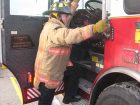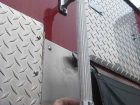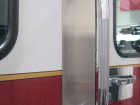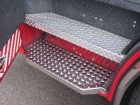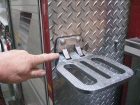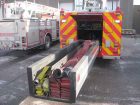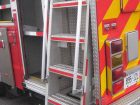
Equipment
Truck Tech: February 2016
Firefighters may be injured while performing actions for which they have been trained, but injuries while getting on or off the rig or while removing a piece of equipment can be avoided. Understanding a fire truck’s ergonomic features and their maintenance can help prevent unnecessary injuries.
February 12, 2016
By Chris Dennis
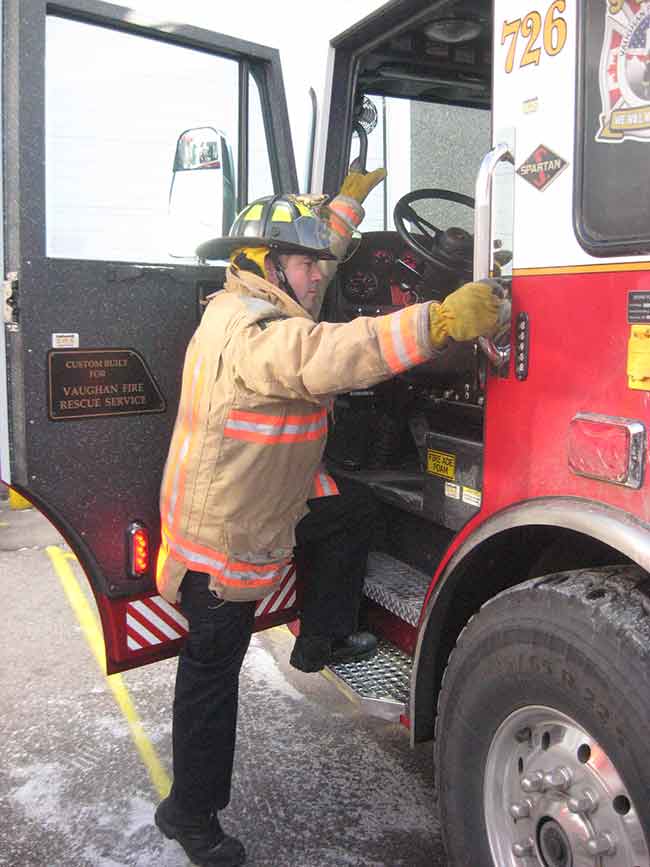
Firefighters are a health- and safety-driven group so fire trucks generally include steps, grab handles, fall-arrest points, tailboards and elevated device platforms. I have seen many custom and commercial-built fire trucks over the years and am continuously blown away with new gidgits and gadgets and how they are properly stored on the apparatus.
■ Grab handles
In Ontario, occupational health and safety guidance notes for prevention of falls from apparatus say that employers should take every reasonable precaution to protect firefighters from the hazard of falls, including on fire apparatuses. It states, “. . . equip fire trucks with sufficient anti-slip handle-holds to allow firefighters to use the position known as the three-point contact method when entering or exiting the cab.”
This means firefighters should always have three points of the body in contact with the truck while climbing up into or down from the cab. Photo 1 shows a firefighter who has two hands and one foot firmly grasping or standing on the truck.
Photo 2 shows a good grab handle on a typical fire truck. All handles are secured to the body of the cab or apparatus by brackets, sometimes called stanchions ends. These ends are made of metal products, which means they are prone to corrosion. In previous columns I have warned about the effects of corrosion on trucks, especially when brine and dissimilar metals are involved. NFPA 1901 says, “Corrosion protection commonly known as undercoating might be advantageous.”
Grab handles can erode. But corrosion is hard to spot because it usually occurs on the backsides of handles rather than forming on the visible section. A corroded handle splits open and weakens and breaks the anchor bracket that is attached to the truck body. The breaks usually happen when firefighters firmly grasp the handles to pull themselves up onto the steps, cab areas or apparatus bodies.
Photo 2 shows where the rounded handle slips securely into the anchor bracket. There is no way to stop corrosive slurry from sliding down the handle into the anchor, where it sits and festers. The result is a galvanic corrosive reaction that, similar to ice, pushes on the metal until it splits and cracks. When a firefighter puts his or her weight on the handle, the mount bracket will break away, causing a fall.
To help prevent a dangerous-handle scenario, be sure that when trucks are washed, all grab handles are cleaned as well and inspected all the way around. At Vaughan Fire & Rescue Service we have added dielectric grease to the anchor-bracket areas and drilled holes in the bottoms to allow slurry and water to run back out before they need replacement. We previously siliconed the grab handle to the anchor as well, but have found it seals in what corrosive slurry does get in, and so the handles fail quicker. If a truck’s handles are designed as single, smooth welded components then the failures are not so bad (see photo 3 of a one-piece handle), but these, too, must be inspected where they bolt to the equipment. If bolts are not stainless, stress and corrosion may cause them to break away as well.
A truck’s rear tailboards, ladder turn-table access areas, side pump-panel steps, cab steps, walkways and protective side railings are all areas created for three-point contact, and all require inspection and maintenance. The best line of defence is regular washing and drying. If there is stick-on skid material, be sure it is well fastened down and is not torn, which can be a tripping hazard. The steps to the cab as well as tailboards, folding steps and body climbing points are all specified in the NFPA 1901 guidelines. The standard strongly recommends that chassis and apparatus manufactures be consulted concerning available alternatives to ensure crew access is as ergonomically convenient and as safe as possible. It also says step size and placement should ensure at least 175 millimetres to 200 millimetres (seven to eight inches) of a firefighter’s boot is supported.
Both commercial and custom trucks can be built to NFPA’s standards. Commercial fire truck builds, however, are not standard and so must be built to a spec in order to meet some of the 1901 requirements. Most custom fire truck builders such as Pierce, Spartan, Smeal, Rosenbauer and ERV chassis all make 1901 a standard build spec when they create an NFPA-compliant rig. Ask the manufacturer for clarification if you are building to an ergonomic guideline as well.
Cab steps need to be inspected during regular truck checks (see photo 4 of cab steps). The steps on both custom and commercial chassis see a lot of foot traffic, especially if it is a busy hall and a busy rig. Check all welds and anchor points and ensure any anti-slip surfaces are completely intact. All snow, ice and mud should be washed away to prevent slips coming out or climbing back into the cab. The same is true for tailboards and side-step or side-board access points. Use extra caution during cold months for side-step or side-board platforms where firefighters stand, especially if they are under a fire pump discharge or intake area. Ice builds up quickly and can be very dangerous on the ground as well as the body step points. Three points of contact are imperative. If a firefighter’s foot slips he can at least hold onto grab handles.
■ Hose-load ergonomics
Depending on the spec, a rig may be equipped with a pre-connected transverse fire hose load or maybe a preconnect rear-access hose load, a booster real, dead loads, pre-connected exposure load, or even the simple length of hose hanging out of the back to hook to a hydrant. These hose areas all have to be inspected and maintained, and in these cases, dirt is the biggest issue. Washing and drying these hose-load areas make it safe to access the hose itself.
There are many ways to pack a hose load and every department has a method of doing so to ensure that the line can be quickly and safely deployed. Climbing up on the truck to pull off the hose when the excitement and the adrenaline are all going, is when you would expect there to be an accident. Oddly enough, injury more often occurs when reloading the hose, when firefighters are fatigued and make mistakes.
During an apparatus spec-building process, ergonomics as well as fall prevention should be taken into consideration. Let’s say, for example, you have a custom pumper with a hydrant hit load of 1,000 feet of high volume and a pre-connected 800-foot load of 65-millimetre (2 1/2-foot) hose on top of the apparatus body with access to reload from the sides and the rear. If the truck is equipped with a two-piece solid hose-bed door, both sides have to be opened before the hose can be reloaded. These two half doors are long and can be heavy. Consider pricing out an electrically operated hose-bay door system so firefighters do not have to climb up and fight to get the doors open while still trying to keep three points of contact. The open doors have hinges and so become a form of fall protection so that firefighters with proper PPE can work on top of the hose-bed area to reload.
A tarped hose load is easier to access, however, if the fall-protection component is missing along the sides, and firefighters have no protection unless they are tied off. Climbing up to that point also requires proper steps and handles for firm three-point contact. Some trucks have steps that flip up or down (see photo 5), which must be washed and lubricated in the hinge area. Clean off any lubrication that drips onto the foot rest area with a degreasing soap or agent.
How many times have you followed a highway truck or van body vehicle on the road in the winter months, or down a dirt road and watched all the snow, ice and dirt stick to the back of the truck? The same thing happens with fire trucks. A quick wash of the back does not remove all of the dirt. Go the extra mile and hand wash all steps and re-lube pivot or hinge points. Use liquid soap to wash away the dirt, and use the soap as the lubrication agent. Use caution because, once wet, the truck will be extra slippery with the soap.
Some fire-truck builders take ergonomics to the next level. Smeal uses what is called an ergonomic hose loader (EHL). The EHL tray slides in and out of the back of a fire truck (see photo 6), and brings the hose load down to waist level where it can be safely reloaded. Check out all apparatus builders for custom ergonomics when specing a truck, including switch placement in reference to crew positioning, power up and down cradles for porta tanks, hose-bed door covers, EHLs, air-cylinder deployment, and so on.
■ Ladders and pull-out trays
The aerial apparatus, quint, platform, snorkel and so on, all have to be accessible in order for firefighters to operate the equipment. NFPA 1901, chapter 19, speaks to safety and recommends ergonomics for elevated devices such as the ladder (see photo 7). Fabricated ladders or steps also fall under 6-29 in Ontario’s Occupational Health and Safety Act. The points at which the ladder components are attached to the body should be inspected for early corrosion. If deployment sensors are part of the ladder’s design operation, these too can be washed with mild soap and water and rinsed. Newer deployment sensors are proximity or magnetic switches, while older ones may be mechanical switches with moving levers or springs; both should be inspected and cleaned. The switches are electrical, so they can work one minute and not the next, similar to a light bulb in your home. If a ladder step or porta tank is left in the deployed position and not stowed it may cause extensive property damage or personal injury. Be sure to check the deployment warning system as you would a door-open warning system; have someone in the cab deploy the ergonomic feature to be sure it is functioning. Be sure to follow all departmental policies, procedures and guidelines for safe operation and correct PPE usage.
Pull-out trays located inside the body of the apparatus in the compartments are usually either pulled out and tipped down or slid out as trays. Slide-out trays also include outside trays that are used as steps. For example, a slide-out tray is a suggested requirement with a pump panel configured on officer, driver or rear-mount pump control panel where an elevated device is built on an apparatus. On a quint, a slide-out step, tray or working platform is required to keep the pump operator off the ground when the elevated device is in use. Should the elevated device come in contact with electrical wires the pump operator will not suffer electric shock because the firefighter is not on the ground. Trays need to be maintained often; slide them out, power wash them, lubricate the tracks and rollers and, if supplied, grease serts, add lubricant and slide back into place until the next truck check or the next time they are used.
Ergonomics is key to firefighters safely getting on and off the trucks as well as moving equipment off and on. While cleaning, go slowly, finish whatever you started and do not become complacent. Treat every day as though it is the first day on the job so that the odds of being safe are in your favour.
As always, stay healthy and safe my friends – rubber side down!
Chris Dennis is the chief mechanical officer for Vaughan Fire & Rescue Service in Ontario. He can be reached at Chris.Dennis@vaughan.ca
Print this page
